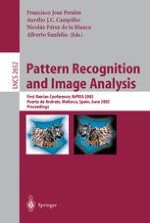2003 | Buch
Pattern Recognition and Image Analysis
First Iberian Conference, IbPRIA 2003, Puerto de Andratx, Mallorca, Spain, JUne 4-6, 2003. Proceedings
herausgegeben von: Francisco José Perales, Aurélio J. C. Campilho, Nicolás Pérez de la Blanca, Alberto Sanfeliu
Verlag: Springer Berlin Heidelberg
Buchreihe : Lecture Notes in Computer Science
Enthalten in: Professional Book Archive
